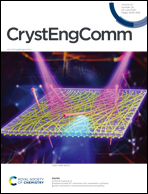Five water-stable luminescent CdII-based metal–organic frameworks as sensors for highly sensitive and selective detection of acetylacetone, Fe3+ and Cr2O72− ions†
Abstract
Five new CdII-based ternary metal–organic frameworks (MOFs) constructed from structurally related ligands, namely, [Cd(L1)(DCTP)]n (1), [Cd2(L2)2(DCTP)2]n (2), {[Cd2(L3)(DCTP)2]·3.75H2O}n (3), {[Cd(L4)(DCTP)]·0.85H2O}n (4) and [Cd0.5(L5)0.5(DCTP)0.5]n (5) (H2DCTP = 2,5-dichloroterephthalic acid, L1 = 1,4-di(1H-benzo[d]imidazol-2-yl)butane, L2 = 1,5-di(1H-benzo[d]imidazol-2-yl)pentane, L3 = 1,3-bis(1-(pyridin-4-ylmethyl)-1H-benzo[d]imidazol-2-yl)propane, L4 = 1,4-bis(1-(pyridin-4-ylmethyl)-1H-benzo[d]imidazol-2-yl)butane and L5 = 1,6-bis(1-(pyridin-4-ylmethyl)-1H-benzo[d]imidazol-2-yl)hexane), have been hydrothermally synthesized and characterized. While 1 and 5 show the common 2D hcb and 3D sqc6 topologies, respectively, 2 exhibits a rare (4,4)-connected 2-node 2D 4,4L62 network, 3 reveals an unprecedented 3D (3,3,4,5)-connected framework with the point symbol {4·92}2{42·82·92}{42·84·93·10}2{93}2 and 4 presents an unusual (3,5)-connected 3D gra topological framework. The results show that the coordination mode of dicarboxylate ligands and the auxiliary N-containing linkers have a crucial impact on the structural diversities of ternary Cd-MOFs. Further, 2 and 3 are favorable dual-functional fluorescent sensors for the detection of Fe3+/acetylacetone and Cr2O72− (pH = 4)/acetylacetone, respectively, with high sensitivity and selectivity.



 Please wait while we load your content...
Please wait while we load your content...